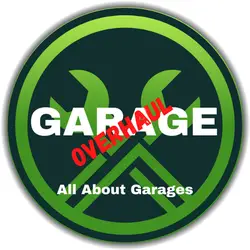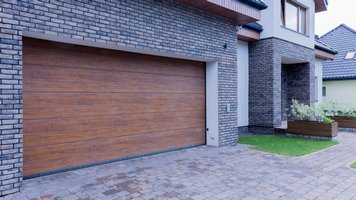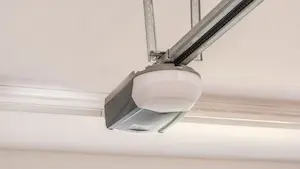Why Is My Garage Door so Heavy? (How to Fix It, Cost)
This post contains affiliate links.
Garage doors are opened many times a day usually. You may use it as the front entrance when you come and go. This constant use wears down all the components little by little. If your garage door suddenly feels heavy to lift, something is wrong.
Your garage door may feel heavy because the garage door springs need to be adjusted or replaced. Garage door springs offset the weight of the door. A problem with the spring tension could cause the door to open or close unevenly or at the wrong speed.
This article explores why your garage door is heavy and what may have gone wrong. We also look into garage door springs and how to replace them to make your garage door work again.
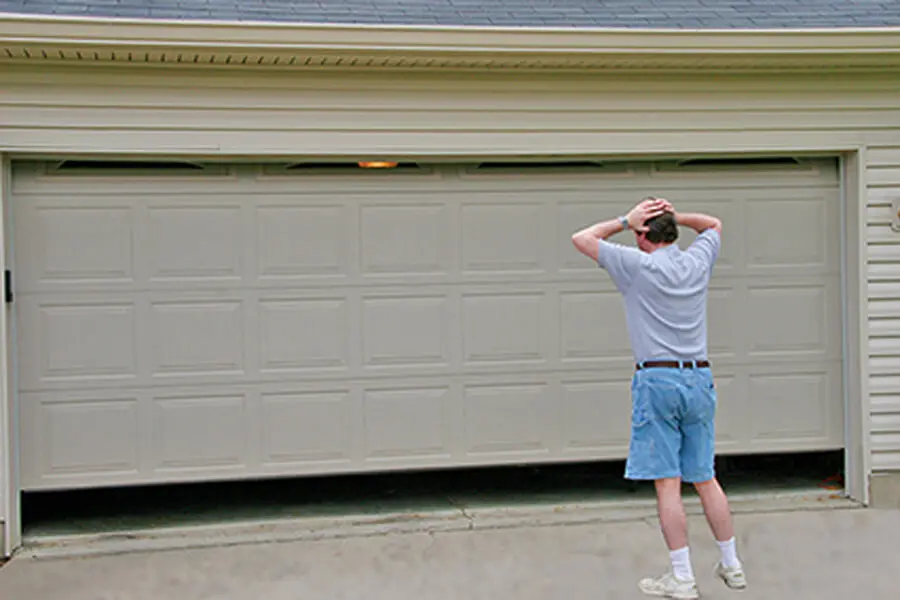
How Much Should Garage Doors Weight?
Your average garage door weighs around 80–300 pounds (a single-door garage). The final weight may depend on the material, thickness, or more. All-glass doors may weigh an average of 400+ pounds. Insulation also adds some weight.
| Type | Weight | Width | Height |
| 25-gauge steel | 75-90 lbs | 8 feet | 7 to 8 feet |
| 25-gauge steel | 150-180 lbs | 16 feet | 7 to 8 feet |
| Heavy Wood | 130-300 lbs | 8 feet | 7 to 8 feet |
| Double door with windows | Over 400 lbs | 16 feet | 7 to 8 feet |
Generally, garage doors are heavy. However, the actual weight of your garage door may depend on many factors. These factors include the material used and measurements of the garage door.
For example, if you are to make your garage door out of 25-gauge sheet steel. The garage door measures 16 feet wide to 8 feet tall. In this case, your garage door should weigh around 75 to 90 pounds (about 34 – 41 kg).
However, the weight can increase significantly. This is if you switch to more solid, thicker materials.
Suppose your garage door is made from heavy wood, such as oak. Your oak garage door measures 8 feet wide and 8 feet tall. In this case, your garage door would weigh up to 300 pounds (about 137kg).
Read More: Different Types Of Garage Doors
These weights usually make garage doors inoperable manually. You will need to have a strong, solid system to do the heavy lifting for you. This is when garage door springs come into the picture.
What Are Garage Door Springs?
Garage door springs help manage the weight of garage doors when opening and closing. They make garage doors feel light, so you do not need to exert a lot of energy to lift them. There are two major types of garage door springs – torsion beam and extension.
Since garage doors can be very heavy, garage door springs were invented to help manage them. It functions like other arms that help you lift the garage door when you open it. This means you do not need to exert much energy to lift up your garage door.
There are two major types of garage door springs. The first is torsion springs, and the second is the extension springs.
Torsion Springs
Torsion springs are mounted above the door and run along a metal shaft that’s parallel to the door’s top. Aluminum drums are placed on either end of the metal shaft, and the springs are wound to a specific torsion.
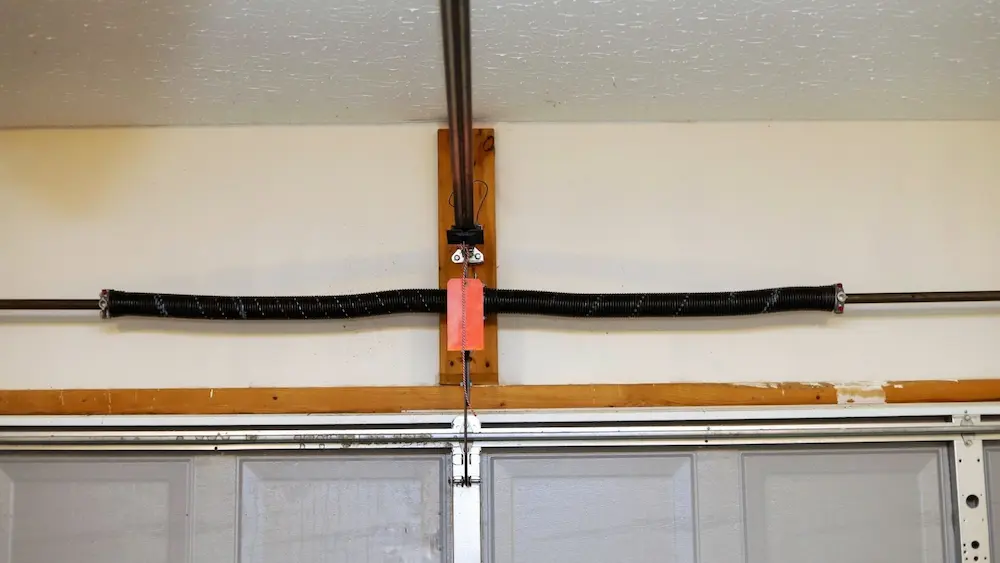
Lighter and smaller garage doors may only have a single torsion spring. Larger and heavier doors may have two springs, with one located on either side of the central plate.
You can further break down torsion springs into several types:
Standard: Standard torsion springs are usually used in residential garage doors. These are the most common torsion beam garage door springs you can find.
Early Set: Early set torsion springs are mounted in the middle of the torsion shaft. These are also quite common with residential garage doors.
Steel Rolling Door: These torsion springs are commonly used in commercial and industrial buildings. Rolling garage doors are more common in these types of buildings.
TorqueMaster: This is a unique torsion spring system for garage doors from Wayne Dalton. It keeps the springs inside a tube and may come with winders with round dials.
Torsion springs can also be finished in several ways, depending on the price you paid for them. The finishings generally lengthen the operation lifespan of the spring.
Oil-Tempered: Oil-tempered springs have a long lifespan. They are also cheap to buy and maintain. However, it has an oily, greasy look.
Galvanized: Galvanized springs are given a zinc coating. This prevents it from rusting quickly. This is common with garages in humid areas.
Powder Coated: Powder-coated springs also serve as a way to fight rusting. The color also makes the springs more attractive to the eye. Non-oily.
Torsion spring replacement costs anywhere from $75 to $150 per spring. The price includes materials and labor. The springs alone run $30 to $100 each. You’ll almost always have two springs per door, and you should replace both at the same time.
A properly balanced and adjusted torsion spring will counterbalance your door weight. Up to 90% of the garage door weight can be taken up by your spring. That means a typical double-car garage door weighing 200 lbs will only require 20 lbs of force to move.
We also have a detailed guide on how you can change your garage door torsion springs. Check it out if you intend to do so.
Extension Springs
Extension springs store energy by extending or stretching when the door is moved. These are side-mounted and run above and parallel to the door tracks.
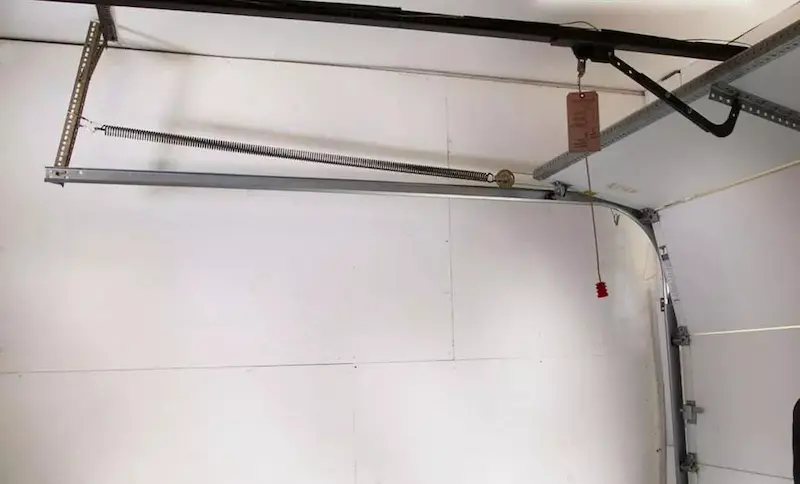
Extension springs work in parallel with pulleys and cables. The cable, which holds the spring, attaches to hooks in the track hanger assembly. There are two springs: one above each track on either side of the garage door.
Similar to torsion springs, you can break down extension springs into several types:
Open Looped: Open-looped springs are the weakest but also the most affordable. Expect to have to change springs frequently if using this spring.
Double Looped: Double-looped springs are a lot stronger. It essentially has double the durability of an open-looped spring. This is one of the most popular extension springs for garage doors.
Clipped End: Clipped-end extension springs are the most durable, although expensive. They are also quite common with more modern garage doors.
Extension springs cost $50 to $100 per spring to replace. The price includes both labor and materials. The springs alone run $15 to $45. They’re easier to install and cost a bit less than torsion types.
Extension springs need to be fitted with safety cables. If spring breaks, the safety cable will hold it in place, preventing them from causing damage.
We also have a detailed guide on how you can change your garage door extension springs. In case your garage door uses extension springs, check out our guide here.
How Much Weight Can Garage Door Springs Carry?
A garage door spring can lift up to 750 pounds (about 319kg), depending on the type and setup of the spring. Larger garage doors require stronger springs in larger numbers. The key is to balance the door weight with the spring’s lifting force.
| Door | Door Weight | Recommended Lifting Force |
| Single Doors | Up to 150 lbs | ¼ or ⅓ horsepower |
| Single and Double | Up to 350 lbs | ½ horsepower |
| Double | Up to 600 lbs | ¾ horsepower |
| Special | Up to 740 lbs | 1 horsepower |
| Commercial | Up to 750 lbs | 1 ¼ horsepower |
When you open your garage door, the springs do most of the heavy lifting. This counterbalancing effect makes it possible for you to lift the door.
The system requires you to pair the right springs with the door weight. The general rule is that the heavier the door, the more lifting force you will need from the springs.
For example, suppose your garage door weighs 350 pounds. In this case, the advice is to have a garage door spring setup to generate ½ horsepower of lifting force.
Too little, and then the garage door becomes too heavy for you to lift. Too much lifting force and your garage door may not shut down properly. It may also pull the garage door with too much force, causing it to slam.
If paired with the right garage springs, your garage door should only feel 10 to 20 pounds only. This means you can open and close the door with one hand.
How Long Do Garage Door Springs Last?
Most garage door springs are built to last up to 10,000 cycles. Assuming you open and close the door 3-4 times a day. This should mean your garage springs should last around 7 to 12 years. Higher-quality springs may last longer.
| Daily Cycles | 10,000 Cycles | 20,000 Cycles | 50,000 Cycles |
|---|---|---|---|
| 2 | 14 Years | 28 Years | 68.5 Years |
| 4 | 7 Years | 14 Years | 34 Years |
| 6 | 4.5 Years | 9 Years | 23 Years |
| 8 | 3.5 Years | 7 Years | 17 Years |
| 10 | 3 Years | 6 Years | 14 Years |
Garage door springs are quite durable, actually. Most garage door springs are rated at an industry-standard 10,000 cycles. Each cycle includes opening and closing. Most garage doors may go through 3-4 use cycles each day.
Assuming your springs were installed and calibrated correctly. In this case, you can reasonably expect them to last an average of 7-12 years.
As you use them, garage door springs are put under strain. They get stretched, unstretched and re-stretched thousands of times during their life. They eventually lose the ability to hold a “charge” effectively.
This means they generate less and less lifting force, requiring you to put in more force to lift the door. Eventually, the springs fail and require you to replace them.
How Do I Know If The Garage Springs Are Broken?
Depending on the garage spring type, you can visually tell if a garage door spring is broken. Torsion springs will have gaps on the coil or the body of the spring. Extension springs may have missing hooks on either side of the springs or gaps on the coil of the spring.
As garage door springs deteriorate and break down, they lose lifting strength. They also display signs of wear that you can eventually see.
Torsion Springs: With torsion springs, you usually will see signs of wear and tear in the coil of the spring. These should show up as gaps between the spring coils. There may also be signs of rust.
Extension Springs: Extension springs may show similar issues with torsion springs, such as gaps in the coil. The hooks at the ends of the springs may also bend or break.
TorqueMaster: TorqueMaster springs have safety features. It prevents the door from coming down again when the spring breaks.
What Causes Garage Door Springs To Break?
Garage door springs break for many reasons. For example, rust, lack of lubrication, and poor maintenance. Cheap springs and extreme temperatures can also wear out springs fast. Springs also eventually wear out from wear and tear.
Many reasons can cause door springs to break, such as rust and lack of lubrication. Poor maintenance, cheap springs, and regular wear and tear also can break springs.
Read More: Garage Maintenance
Extreme winter temperatures also cause garage door springs to break. The following list is reasons why garage door springs break and ways to extend their life.
Rust: Any moisture that contacts the springs makes the coils rust and weaken. Protect the springs from rust with lubricant or White Lithium Grease. These protect your springs better than regular WD-40.
Lack of Maintenance: Check the balance of the springs annually by opening the garage door halfway. If the door stays in the middle, the springs are in good condition. If the door keeps moving up or down, or if one side moves up at a different speed, the springs need maintenance.
Cheap Springs: The cheapest springs use lower-quality metal coils that tend to break faster. Investing in higher-quality springs reduces repairs and saves money in the long run.
Cold Climates: In winter temperatures, metal springs contract and have a higher chance of breaking. Insulating the garage and keeping the door closed helps shield the springs from the cold.
Wear & Tear: The more you open and close your garage door, the faster the springs wear down. Investing in high-cycle springs could provide up to 50,000 cycles. Regular springs only provide 10,000 cycles.
How Much Does Garage Door Spring Replacement Cost?
Garage door springs may cost between $20 to $100, depending on the type of spring you and the lifting force you need. Your cost may also go up if you intend to hire out the job and have professionals come in to replace the springs for you.
| Spring Type | Springs | Labor | Replacement Cost |
| Single Torsion | $30 – $70 | $110 – $200 | $140 – $270 |
| Double Torsion | $50 – $100 | $150 – $250 | $200 – $350 |
| Single Extension | $20 – $40 | $100 – $120 | $120 – $160 |
| Double Extension | $30 – $50 | $130 – $150 | $160 – $200 |
If your garage door springs need replacement, you can take an easy breather. This is because garage door springs are, in general, not too expensive.
A garage door spring’s price starts from a low at $20 if you only need to replace a single extension spring. However, if you are going to replace both of your torsion garage springs, that may cost you $100 or more.
Your cost may go up more if you plan to have people come in and replace the springs for you. This is understandable, especially if you are not comfortable with replacing things yourself.
If you hire out the job, you may be looking at a total replacement cost of around $120 to $350. This, again, depends on the types of springs and the number of springs you are replacing.
How Much Does a Garage Door Repair Cost?
If you hire professionals to come and fix problematic garage doors, the cost may range from $40 to $350. The price may differ depending on the nature of the repair work and the time needed to fix the issue.
Broken Garage Door Spring Repair Cost
| Problem | Symptoms | Solution | Repair Cost |
|---|---|---|---|
| Broken Spring | Door won’t open or struggles to move Springs shows a gap of a few inches Door crashes down when operating Door is heavy, hard to lift Opening motor works, but the door doesn’t move Loud bang or snapping sound when door moves Loose, hanging cables Door becomes crooked Door opens and closes in a jerky way | Spring Replacement | $120-$350 |
| Imbalanced Springs | Difficult to operate | Spring Tune-up | $40 – $80 |
| Stretched Springs | Door won’t stay fully open Moves slower up or down | Spring Replacement | $120-$350 |
| Broken Cables | Door becomes uneven One side becomes heavier Door will fall down if both cables are broken Door came off its track | Cable Replacement | $85 – $185 |
| Springs Require Maintenance | Garage door makes noise when operating | Spring Tune-up | $40 – $80 |
| Wrong Size Spring Installed | Door moves too quickly or feels too light or heavy to open | Spring Replacement | $120-$350 |
Garage Door Spring Costs
| Project | Average Cost |
|---|---|
| Replace Torsion Springs | $140 – $350 |
| Replace Extension Springs | $120 – $200 |
| Convert Extension to Torsion System | $200 – $500 |
| Replace Springs and Cables | $200 – $500 |
| Replace Cables Only | $80 – $185 |
| Torsion Spring Parts | $30 – $100 |
| Extension Spring Parts | $20 – $50 |
| Spring Tune-Up (Winding, Balancing, Lubricating) | $40 – $80 |
Garage Door Spring Prices
| Torsion | Extension | |
|---|---|---|
| Pros | Most common Longer lifespan Safer to use Smoother operation | Better for places with less headroom Cheaper Less maintenance |
| Cons | More expensive More maintenance | Shorter lifespan Jerky operation Dangerous when it breaks |
| Price | $30 – $100 | $20 – $50 |
| Cycles | 10,000 – 20,000 | 5,000 – 15,000 |
| Lasts | 7 – 14 Years | 4 – 10 Years |
The garage door spring system does not just consist of springs. It also contains other parts such as cables, rails, and the door. If any of these parts are faulty, you may need to call professionals to come in and help fix the issue.
In this case, depending on the types of problems you are facing, the repair bills may be different. For example, suppose you notice your garage door springs look good. However, they are making a lot of shrieking noise. In this case, it may need some tune-up and lubrication.
In this case, the garage door professional should only bill you between $40 – $80 for the job. This is because the work is simple and does not take too much time. However, suppose the garage springs are broken and require replacement. In this case, you may be looking at a higher repair bill.
This is because the technician needs to spend more time removing the old springs. Then, they need to install new ones. They also need to source for the springs, which means additional costs for them.
These professionals may charge a fee for their services. But understand that they usually deliver a good job. The bills pay not just the springs but their time and your peace of mind.
How Much Does It Cost to Repair or Replace the Garage Door Springs?
If you want the job done by professionals or DIY, Here is up-to-date info at Homeadvisor.com and Homeguide.com
https://homeguide.com/costs/garage-door-spring-replacement-cost
https://www.homeadvisor.com/cost/garages/garage-door-spring-repair/
Can You Replace the Garage Door Springs Yourself?
You can replace your garage door springs yourself. However, ensure you have the right tools and are wearing the right safety gear. You will be dealing with springs and heavy doors. This means accidents are likely to happen if you are not careful.
Changing garage door springs is not rocket science; it is something anyone can do. However, it is important to ensure you know what you are doing. This is because the risk of injury is high.
You will be dealing with objects such as springs, which may bounce around if you are not careful. Aside from that, garage doors are heavy objects. Without springs to hold onto them, they may slide down and slam on the floor hard.
If you are unlucky enough to stand in the way of the doors, you may be looking at some serious injury.
You also want to make sure you possess the right equipment and safety gear to perform the job. At the most basic, you will need some hand tools.
Another thing you want to be careful about is when buying your springs. You need to ensure you get the right spring with the right lifting power for your garage doors.
If your garage door uses extension springs, the general steps to replace them are as follows:
- Open the garage door fully and secure the door
- Detach the extension spring
- Disconnect the lift cable
- Disconnect the safety cable and remove the old spring
- Reattach the safety cable by threading it through the new spring
- Reattach lift cable
- Lubricate and test spring
Read More: How To Replace Garage Door Extension Springs
If your garage door uses torsion springs, the steps you can do replace them are:
- Close the garage door fully and secure the door
- Unwind the torsion spring
- Unbolt the pulley and detach the door cables
- Remove the main bar from the wall bracket
- Slide pulley and old spring out
- Slide new spring and pulley in
- Reinsert the main bar into the wall bracket
- Reattach door cables and bolt back pulley
- Wind the torsion springs
- Lubricate and test the spring
Read More: How To Replace Garage Door Torsion Springs
